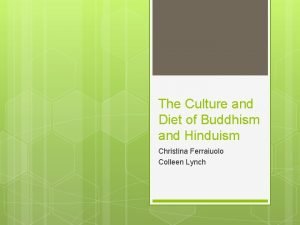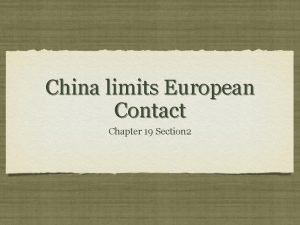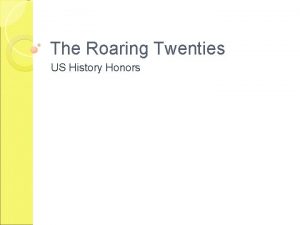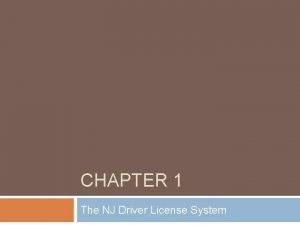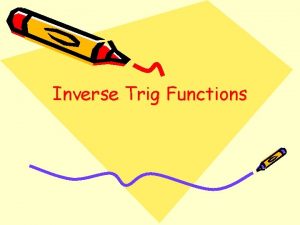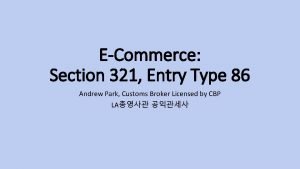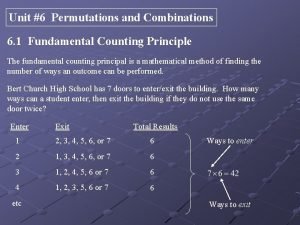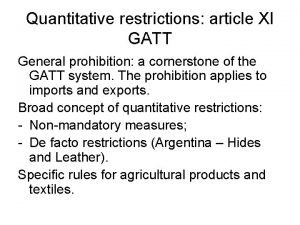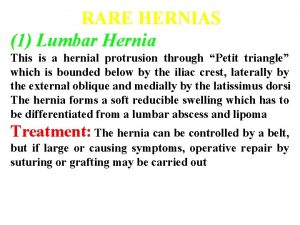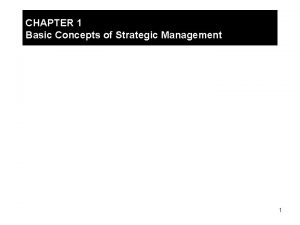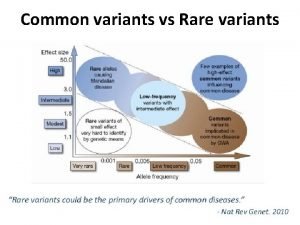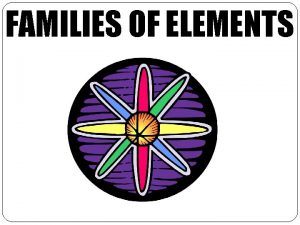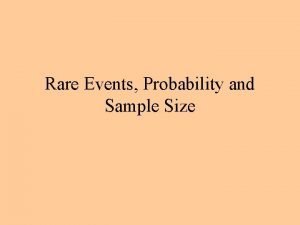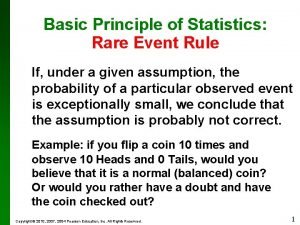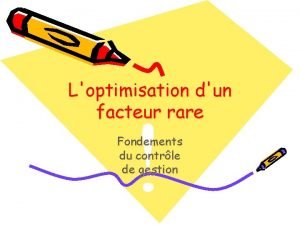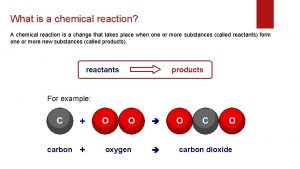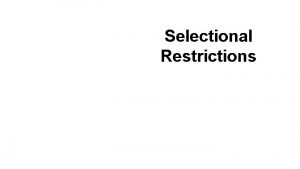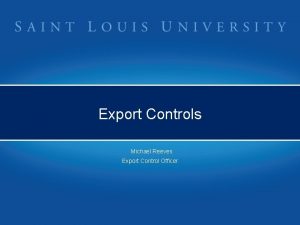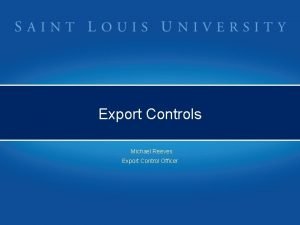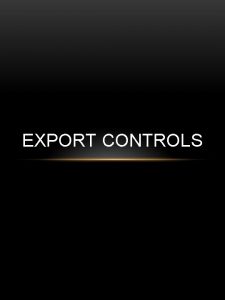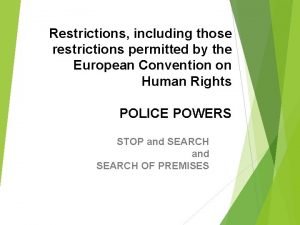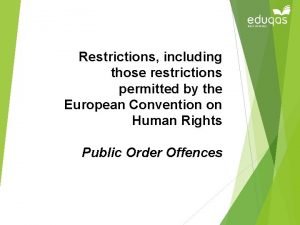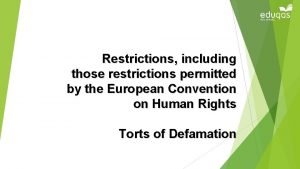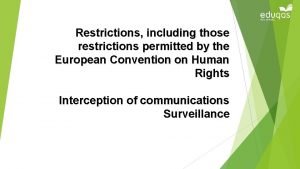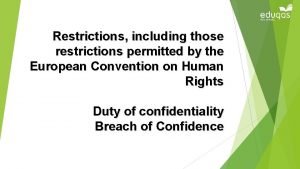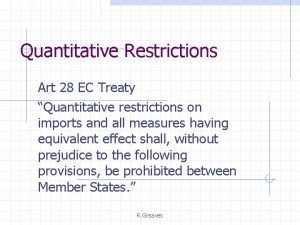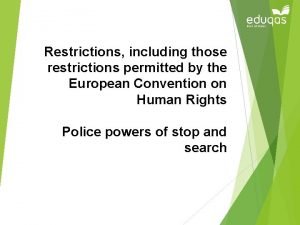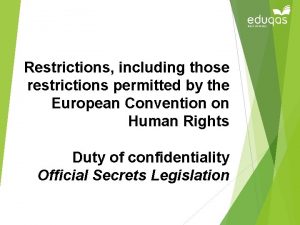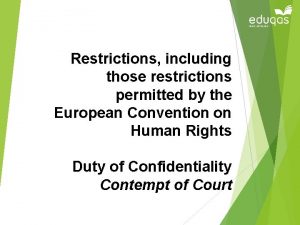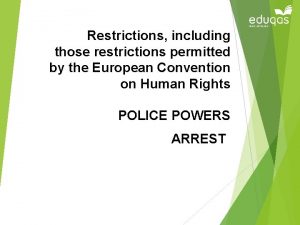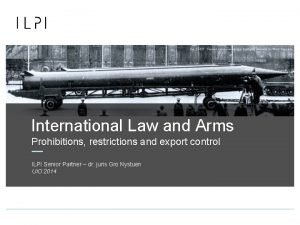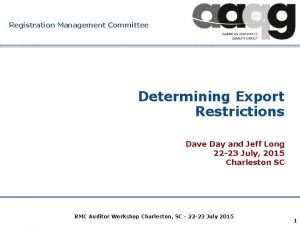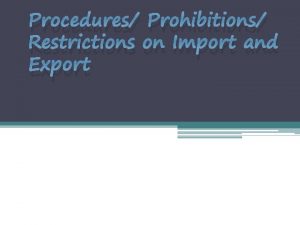U S vs China Export Restrictions on Rare





















- Slides: 21

U. S. vs. China Export Restrictions on Rare Earths ITRN 603 - Global Trade Relations Amro Abdulati Folasade Adeyanju Maimoona Asghar

WHAT ARE RARE EARTH ELEMENTS Rare earth elements are a group of seventeen chemical elements that occur together in the periodic table. The group consists of yttrium, scandium, and fifteen lanthanide elements (lanthanum, cerium, thulium, ytterbium, praseodymium, gadolinium, terbium, dysprosium, neodymium, promethium, samarium, europium, holmium, erbium, and lutetium)

USES OF RARE EARTH ELEMENTS They are used in consumer electronics, computers and networks, communications, clean energy, advanced transportation, health care, environmental mitigation, national defense, and in many other ways. .

ARE THEY RARE They are available all over the world but in rare concentration. However, a few regions of the world, like South Africa, United States of America, Russia, India, China, Brazil, Canada, Malaysia & South East Asia have abundance of these elements.

RARE EARTHS SUPPLIER 1950 s - SOUTH AFRICA, INDIA AND BRAZIL 1960 S TO 1980 S- UNITED STATES OF AMERICA 1990 S- CHINA

Prior Proceedings (Amro) - - China currently caters to 97% of the global demand regarding these rare material which includes different elements and metals. Other than exporting it also manufactures 60% of rare finished goods to meet the demand. According to researchers, China has 36. 5% share of these raw material all over the globe making it the biggest exporter around the world. (Smith Stegen, 2015) In 2010, Chinese government has drastically cut of their export quotas by 40% which was the major concern for many developing countries. These restrictions have automatically rattled the confidence of international market since a limited amount is exported. (Hatch, 2012)

History and Context (Amro) In joining the WTO, the Chinese government agreed its commitments on export duties as contained in the Protocol of Accession and the rules governing export quotas which are embodied in the General Agreement on Tariffs and Trade (GATT) of 1994. The rules include: - - A general prohibition on the use of quantitative measures, such as quotas, for the purpose of export restrictions in Article XI. 1. Under certain conditions, exceptions to the general rule are permitted under Article XI. 2. General exceptions to the prohibition on export restrictions are available for environmental purposes, for example the "protection of animal, human and plant life and health" and the "conservation of natural exhaustible resources" in Article XX.

Prior Proceedings (Amro) - - A formal complaint was made by US, EU and Mexico in 2009 to WTO against the restriction imposed by China. The WTO was to settle the dispute regarding the issue. Dispute settlement body (DSB) ruled against China in January 2012, the restrictions on the specific rare earth materials were removed after the reasonable period of time was given to china. The second formal complaint was made for two other major rare material known as tungsten and molybdenum by the alliance of EU, Japan, and the US.

WTO Case (Sade) DS 431 - U. S. vs. China - Rare Earths Complaint: United States Respondent: China Relevant WTO Issue: Export restrictions on a number of rare earths, tungsten, and molybdenum Chinese Export Restrictions: ● Export Duties ● Export Quotas ● Limitations on the enterprises permitted to export the products. Products at issue: Various forms of rare earths, tungsten, and molybdenum

WTO Case (Sade) ○ On March 3, 2012, U. S. requested consultations with China. ○ Requested Materials Included ■ ■ Materials falling under 212 eight-digit Chinese Customs Commodity Codes and over 30 measures. Chinese published and unpublished measures that impose and administer export restrictions ● E. g. Export duties, export quotas, minimum export price requirements, export licensing requirements and additional requirements and procedures in connection with the administration of the quantitative restrictions.

WTO Case (Sade) U. S. Complaints ● ● ● China applies export duties on various forms of rare earths, molybdenum, and tungsten. Inconsistency with China’s WTO obligations due to China undertaking to eliminate all export duties, except for those imposed on a number of products listed in Annex 6 to China’s Accession Protocol. a. Export Quotas b. Trading Rights With the exception of tungsten ores and concentrates none of the products at issue are included in Annex 6, and China is therefore not entitled to impose the export duties on them.

WTO Case (Sade) China’s Counter Argument ● Justified its imposition of export duties on the basis of the “General Exceptions” provision in Article XX of the GATT ○ Article XX(b) allows WTO Members to maintain measures that would otherwise be inconsistent with the GATT 1994 if the measures are necessary to protect human, animal or plant life or health.

Contested Issue (Sade) China’s Environmental and Social Impacts of Mining Rare Earths ● Cost of Mining ○ ○ ● Rare Earth Ores are often laced with radioactive materials such as Thorium Separating the wheat from the chaff requires huge amounts of carcinogenic toxins ■ Sulphates ■ Ammonia ■ Hydrochloric Acid Production processes and techniques in the mining of rare earth ores have caused: ○ ○ damage to surface vegetation caused soil erosion, pollution, Acidification reduced or even eliminated food crop output.

Contested Issue (Sade) China’s Depleting Rare Earth Supply ● ● ● Over the last 50 years of mining, China’s Rare Earth Ores are decreasing China's southern provinces has declined from 50 two decades ago to the present 15 Most of the southern ion-absorption rare earth deposits are located in remote mountainous areas

Contested Issue (Sade) Divergence between Price & Value ● ● The price of rare earth products has remained low and failed to reflect in value Despite a gradual rise in the price of rare earth products, the rise has been much lower than that in the price rise of other raw materials like gold, copper and iron ore. *From 2000 to 2010, the price of rare earth products rose by 2. 5 -fold, while that of gold, copper and iron ore increased by 4. 4 -, 4. 1 -, and 4. 8 -fold during the same period, respectively.

Specific WTO Agreement (Sade) ● WTO Panel Ruling ○ ○ China’s export duties and quotas constituted a breach of WTO rules China failed to justify conservation or environmental protection measures. ● The ruling was based on disagreements over obligations China entered into when it joined the WTO in 2001 ○ ○ Agreed upon prohibitions on export restrictions that are found in the GATT China’s Accession Protocol. ● The Agreement allowed for the commitment of China to more rigorous liberalizations by agreeing to eliminate all taxes and charges related to exports, except to listed materials and those in conformity with GATT Article VIII.

Consistency Of China’s Decision (Maimoona) ARTICLES CITED BY WTO IN THE FINAL DECISION ABOUT CHINESE RESTRICTIONS ON RARE EARTH ELEMENTS GATT 1994: Art. www. wto. org/english/docs _e/legal _e/gatt 47_01_e. htm, XI: 1, X: 3(a) Protocol of Accession: , , Part I, para. 1. 2, Part I, para. 5. 1, , , Part I, para. 11. 3, Part I, para. 5. 2, Part I, para. 8. 2, Part I, para. 7. 2 According to the decision of Appellate Panel, China has not followed the rules of accession protocol.

Implementations & Sanctions (Maimoona) CHINA ACCEPTED THE FINAL DECISION OF THE PANEL OF WTO BUT APPEALED TO SOME OF THE FINDINGS OF THE WTO’S DECISION FIRST, “China appealed an intermediate Panel finding in reaching its conclusion that Article XX of the GATT 1994 is not available to justify a breach of Paragraph 11. 3 of China's Accession Protocol. China contended that the Panel erred in rejecting China's interpretation of Paragraph 1. 2 of China's Accession Protocol and Article XII: 1 of the Marrakesh Agreement as meaning that each provision of China's Accession Protocol is an integral part of the Marrakesh Agreement or of the Multilateral Trade Agreement to which that provision “intrinsically relates”.

Implementations & Sanctions (Maimoona) SECOND, “China appealed limited aspects of the Panel's interpretation and application of Article XX(g) of the GATT 1994, in connection with its findings that the export quotas at issue are not measures “relating to” the conservation of exhaustible natural resources and are not “made effective in conjunction with” restrictions on domestic production or consumption. ” In the end, China accepted to implement WTO’s decision and withdrew the export restrictions and duties on rare earth elements. So no sanctions were applied to China in this case.

Proposal on Trade Issue Purpose of WTO; To Maintain Stability in World Trade Chinese Act of Export Restrictions; Destabilized The World Trade of Rare Earth Elements in the Short Run US, European and Other Countries Act of relying on Chinese Supply of Rare Earth Elements; Destability in the trade of rare earth elements in the Long Run

Proposal on Trade Issue RULE OF NON- DISCRIMINATION AS PER ACCESSION PROTOCOL According to that rule, “foreign individuals and enterprises and foreign-funded enterprises shall be accorded treatment no less favorable than that accorded to other individuals and enterprises in respect of: the procurement of inputs and goods and services necessary for production and the conditions under which their goods are produced, marketed or sold, in the domestic market and for export;
 China international import export 2019
China international import export 2019 Buddhist dietary restrictions
Buddhist dietary restrictions How did hongwu bring stability to china
How did hongwu bring stability to china Public ignores prohibition restrictions
Public ignores prohibition restrictions Examination permit nj restrictions
Examination permit nj restrictions Range of inverse trig functions
Range of inverse trig functions Entry type 86
Entry type 86 Permutation with restrictions
Permutation with restrictions Article xi of gatt
Article xi of gatt Neural circuits the organization of neuronal pools
Neural circuits the organization of neuronal pools Protrusin
Protrusin A strategic decision is rare, consequential, and directive.
A strategic decision is rare, consequential, and directive. Rare variant
Rare variant Abdomen depresibil
Abdomen depresibil Rare consequential and directive
Rare consequential and directive Are there different types of autism
Are there different types of autism Elements in group 1
Elements in group 1 A plain arch is the simplest of all fingerprint patterns.
A plain arch is the simplest of all fingerprint patterns. Rare event
Rare event Rare event rule
Rare event rule Marge sur cout variable par unité de facteur rare
Marge sur cout variable par unité de facteur rare Why high molecularity reactions are rare
Why high molecularity reactions are rare

